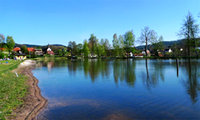De nous à vous, de vous à nous
Camping, tourisme & nature
-

Baerenthal – Legend and reality
Around about 1000 B.C, the Celts, already aware of how to work with iron, settled in Lorraine and in Pays de Bitche which was always a crossroads for invasions. They brought arms and tools with them.
But it’s in a document dated back to 1291 that the Ramstein nobility is mentioned for the first time. Their castle, which overlooks the village, had a short existence for it was destroyed in 1335.
In 1569, Count Hanau Lichtenberg becomes proprietor of the village and in the year that follows he imposes the Protestant religion on the Catholic community of Baerenthal In 1606, boundary stones were laid delimiting the Duchy of Lorraine and the Count Hanau Lichtenberg’s territory. Some are still visible today.
The other castle at Baerenthal, “Grand Arnsbourg” was partially destroyed in 1525, during the Peasants’ War and was completely destroyed in 1680. Under the Convention, Baerenthal with its annex Philippsbourg was detached from Alsace and became part of the department of Moselle.

From the 18th century, the river Zinsel du Nord was used to supply the factories and forges which brought life and work to the valley. The 1st industry, a forge, fabricating weapons, was created in 1745. In 1807, with the creation of a steel works, pudding furnaces and lamination platforms, the forges multiplied along the Zinsel. The fabrication slows down at the beginning of the 20th century and finally ceases its activity in 1932.
The village was spared during the two wars until 1945 when 50% was destroyed when severely bombarded by the Allies. The village was given the Croix de Guerre (French for Cross of War) engraved with a bronze star.









